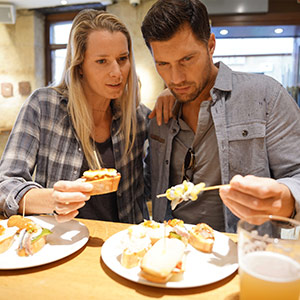
Gourmet markets by day... and by night!
Gourmet tapas and non-stop leisure in historical buildings
It starts raining on your trip without warning. That means looking for an alternative to the walk around the city you had planned for the evening. How about trying some signature tapas while enjoying live music inside a modernist building? Gastromarkets are now a well-established international trend. And this enticing mix of shopping, leisure, fine food and historical Spanish architecture is all part of some of the most beautiful covered markets in Europe. There is a non-stop rhythm in these markets and the hectic selling of fresh products early in the morning turns into relaxed chats with friends, tasting sessions and cultural events that last until dawn. We could mention many more, but here are ten of the most interesting gourmet markets to be found in Spain.
Debe activar Javascript para poder utilizar este servicio
-
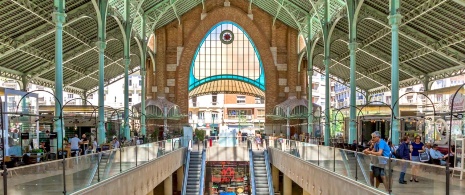
Colón Market, Valencia
The Colón Market, an outstanding example of modernist architecture, was declared a National Monument. The slender pillars built in 1916 stand over a space dedicated to stalls of top-quality fresh products, cafés, pubs, “horchaterías” (bars specialising in horchata, a typical tiger nut drink from Valencia) and restaurants that serve Mediterranean cuisine with a kind of fusion between the traditional and the avant-garde. And every second Sunday of the month there is a large market area with travelling stalls of fashion, decoration and craftwork. A new shopping concept that is brought to life with live jazz.
-
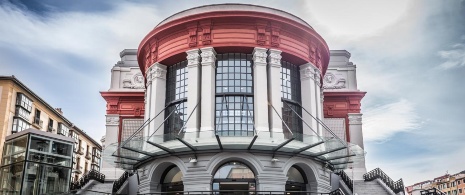
La Ribera Market, Bilbao
A popular stop on gourmet tours around the city of Bilbao is La Ribera Market. It is one of the most iconic buildings in the city: built in 1928 on 10,000 square metres, in Art Deco style. Like many historical markets, this one has also been reinvented. Its large original stained glass has been preserved, it now has a café-theatre with one of the best terraces looking over the river and a “Gastro Plaza” on the first floor. A round of pinchos and the best flavours in Basque cuisine while attending a blues, jazz or rock festival? Workshops and demonstrations to receive cooking tips from professionals? Dozens of craft and international brands of beer? Welcome to the largest covered market in Europe.
-

San Miguel Market, Madrid
San Miguel Market, which has become a symbol of the capital city, contains a variety of stalls that is bound to surprise you. Stalls specialising in seafood, oysters, caviare and fresh fish, where you can choose what you want and have it cooked in front of you; attractive fruit displays where they make natural smoothies to order, dishes made with edible flowers, and even a gourmet bookshop, plus spots to buy last-minute presents, gourmet products and even cosmetics. It is one of the few buildings with iron architecture that has been preserved in Madrid. More than 100 years old, it has a strategic location: right next to Plaza Mayor.
-
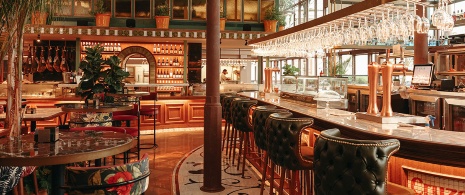
Barranco Market, Seville
Right in the heart of the tourist centre in Seville, next to the Triana neighbourhood, is where this historical building designed by Gustave Eiffel can be found. Used primarily as a wholesale fish market between 1883 and 1970, it is the only iron market that remains in the city. Today, the Barranco Market is a meeting place for leisure, culture and fine food on the edge of the Guadalquivir river where there are more than 150 culinary options spread out over a dozen different stalls.
-
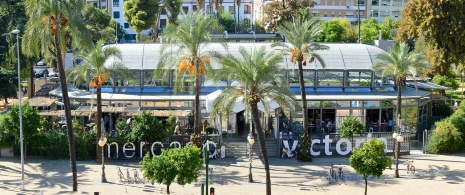
Victoria Market, Cordoba
A demonstration of grape treading (a traditional winemaking technique) a painting contest, ballroom dancing courses and much more. This gastronomic market, the first to open in Andalusia, maintains the essence of a wrought iron building that has been used for events and cultural activities since its construction in 1877. The cuisine on offer is made up of stands specialising in salmorejo, empanadas, roast potatoes, brochettes, Iberian cured meats, fried fish... and a great selection of international cuisine. The location cannot be beaten: right next to the old town of Cordoba, which was declared a UNESCO World Heritage Site.
-

Santa Caterina Market, Barcelona
A large, undulating roof with multicoloured ceramic mosaics that represent fruit and vegetables on top of a wooden structure that respects the original neo-Classical façade. This is the original market of the La Ribera neighbourhood in Barcelona. Remodelled in 2005 by architects Enric Miralles and Benedetta Tagliabue, Santa Caterina has been standing since 1845. Inside you can find stalls selling all kinds of fresh produce, gourmet areas, top-quality oils and preserves, and a wide range of gastronomic options, including vegetarian and oriental dishes.
-
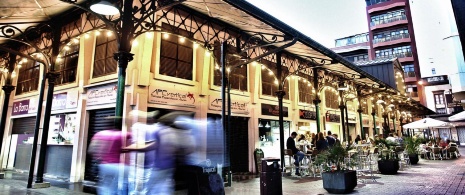
El Puerto market, Las Palmas de Gran Canaria
In a modernist building with a forged iron architectural structure designed by Gustave Eiffel’s team in 1891, you can now enjoy the most typical flavours of Canary Island cuisine such as the famous potatoes with mojo sauce. Here, the task is simple: sample them and ask for them to be prepared on the spot, for a unique gastronomic experience in a space dedicated to the pleasure of eating well and relaxing.
-

Central Market, Cadiz
The ancient columns of this traditional daytime market exist in perfect harmony with the modern gourmet space. The Central Market has become a fashionable space to eat tapas in the city of Cadiz; starting early with an appetiser and going on until past midnight. Chargrilled meat, seafood, fish, vegan food, sushi... In addition to its delightful gourmet offer, this monumental building highlights the authenticity of the inhabitants of Cadiz.
Travel plans for inspiring you













